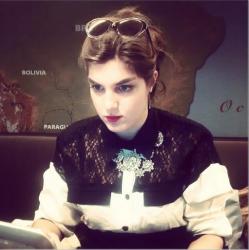Stuart Richardson captures Iceland’s streetlights
The Icelandic winter is supposed to be dark and fierce with a view of the stars and sometimes the Aurora Borealis stretching overhead. It’s cold and windy, sure, but that’s not what bothers photographer Stuart Richardson. It’s the garish illumination of the streetlights that have pervaded the city and are bleeding out into the countryside. “When you’re actually experiencing the Icelandic winter, everything is orange. Everything is the colour of the streetlights,” he says. “When we experience the winter here, we’re not really feeling, we’re not really seeing anything outside of these streetlights.”
Stuart, an American who has been living in Reykjavík for almost six years, photographs the plethora of lamps that light the way when the city is cloaked in darkness for sometimes up to 20 hours a day. ‘Sodium Sun,’ his series currently up in the National Museum through December, started a November day in 2011, “very much out of cabin fever,” he says. He walked outside to photograph something, anything, and was struck by the lights. Stuart had lived in New York City before coming here and was shocked at how well lit Iceland is comparatively. “I think it’s aesthetically interesting, I think they’re pretty,” he says, “but the lights are so unsettling from an environmentalist standpoint.”
Light Pollution
The four photos on display at the museum are large format rectangular prints hung along a wall next to the cafe. All of them feature a winter landscape, though Stuart has taken hundreds of photos, some in the summer, some in the winter. The starburst glow of each light stands out in stark contrast to the deep blue of the sky, the blaze obscuring the definition of everything behind it.
He has colour corrected the photos to remove the orange cast of the sodium bulbs, but hasn’t done any other major editing. “The artificial light is drowning out the natural light,” he says. In a picture of an abandoned construction site, he notes that you can just barely see the mountain looming behind the double row of streetlights that lead to nowhere. “You just get a claustrophobic winter feeling,” he says of being inside the light. “Once you get out from under the streetlights, then you can see the aurora, then you can see the stars.”
This light pollution is only one of Stuart’s concerns about the multitude of lamps all over the country. He started to think about urban sprawl and wasted energy as he photographed this series, noticing the inefficiency in the placement of the lights, which seem to be constructed in such great numbers just because they can be. “In other places where they’re worrying about energy consumption or cost of construction, they think, ‘do we really need all these?’ Here it seems they don’t think of that. Perhaps it’s because the energy’s very cheap.” The lamps seem to be laid out without regard for the most practical way to place them with unnecessary overlaps, as in his image of the roundabout surrounded by lights, though fewer could have been used.
Urban Sprawl
Indicating the photograph on the far right, Stuart explains that it’s of an overpass above a road, and that in the hour or so that he sat there photographing, only three cars went by. Though he concedes that perhaps the multitudes of lights are there and shining all hours a day for those three cars, he wonders if it’s all really necessary. He notes that culturally, there is a reason for this, as historically Icelanders were a people always on the verge of death due to harsh weather and lack of money. “And so it makes sense that the first thing they do when they sort of develop as a nation is they drive away the nature.”
What initially attracted Stuart to Iceland was that untouched nature. Growing up in the very industrially developed New England and living in the even more developed New York City led him to be attracted to places without such a saturated state of growth. Iceland is a country just coming out of isolation, relatively speaking, and with room for growth in a number of areas. “It’s one of the first places I’ve been where not only is there no one around, but there’s the sense that no one has ever been around,” he says, “and you just do not get that feeling in many other places.”
The streetlights marching out into the beautiful landscape of the Icelandic winter represent civilization starting to taint the pure wilderness. There is difficulty with this issue, because on the one hand, the desire to preserve the primordial sense of the world is understandable, but on the other hand, progress with developing land and resources will continue regardless of what anyone wants. Stuart Richardson’s series asks the viewer to think about this particular issue in Iceland, one of the final frontiers.
—
More of Stuart’s work can be found at his website.
Buy subscriptions, t-shirts and more from our shop right here!





















